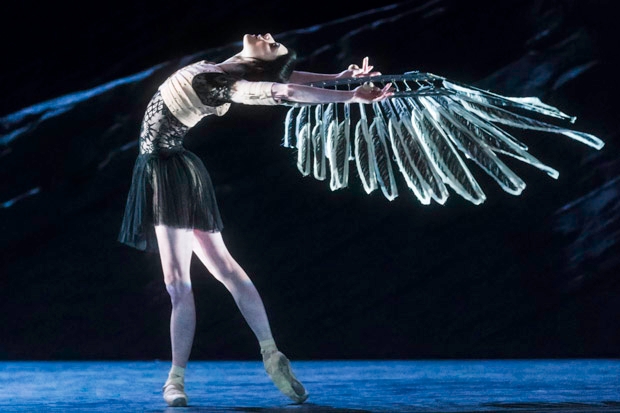The love that asks no questions, the love that pays the price… The amount of unconditional love sloshing about at the Royal Ballet for choreographers and dancers is making this autumn in Bow Street a test of loyalty. At his season press conference Royal Ballet artistic director Kevin O’Hare smilingly promised us that the 2020 season might contain only works made in the past ten years. God preserve us.
Two of the autumn’s three bills so far have been mixed programmes dominated by new or recent in-house contemporary ballets, and only Liam Scarlett’s Viscera, in the current bill, should be longlisted for 2020. The rest should be longlisted for other qualities: Wayne McGregor’s Raven Girl for inelegance, Alastair Marriott’s Connectome for insipidity, and now Carlos Acosta’s Carmen for incoherence. What does an artistic director do, exactly? Direct the art? Or indulge the artists?
We all love Acosta the dancer, with his super-gentlemanly manners and super-ungentlemanly twinkle. It’s tempting to set aside his clunky 2013 Don Quixote (and a few other things), and just think about all the parties we’ve had with him on stage as he takes his final bow this month. But he has been proving he is no good at dramatic choreography for quite some time. The disaster of his Carmen has been written in the cards, en vain pour éviter.
Watching it is very confusing, as if its maker had thrown in every influence he’s danced or seen, a sort of Instagram of choreographic selfies and diary mash-ups. Here are step motifs from favourites like Diana and Actaeon and Mayerling, Cuban-style Fame-school ensembles, an opening scene nodding neatly at The Full Monty, a 30-second flash of a fabulous floor of plastic roses like Pina Bausch’s Nelken meets the Tower of London installation. Apparently on opening night Escamillo had a pink-and-red toreador suit too, but when I went along to see Acosta in that role rather than the weedy José, he was in shirt and tie like a frat boy. Perhaps accountants were already starting to cut losses.
Arranger-conductor Martin Yates has disconnected Bizet’s music from its formidable tautness and dealt it like a croup-ier around all sorts of styles and reference points. Fiona Kimm’s excitable fortune-teller rushes on to sing ‘En vain pour eviter’ with an anticlimactic guitarist, Micaela’s plaintive aria is peculiarly assigned to Carmen and José’s love scene. It defines the lack of purpose.
The Carmen role comes from the legs-wide-open school of ballet seductresses, nothing to equal what Mats Ek or Matthew Bourne reimagined in their versions well known to Londoners. Saturday afternoon’s Laura Morera tried nobly to suggest some sombre shading, playing opposite Acosta’s Escamillo and Federico Bonelli’s hapless José, which only emphasised the material’s inadequacy.
It took the evening cast, the bold junior Tierney Heap, who has a showgirl figure and a smug prettiness like a 1930s B-movie starlet, to see that the ballet is trash, so best dance it like trash. She was maddening, getting in people’s faces, slurring her steps — brilliant. I quite cared when poor Vadim Muntagirov (wasted as José) stabbed her dead.
She was equalled in counterintuitive smarts by Matthew Ball, using his Hugh Grant-ish looks with imagination as Escamillo; where Acosta had displayed his familiar swagger, you did not expect a young City broker-type to pull off such an explosive solo. The very long sex duet that follows borrows motifs from oral and anal, which is different from your usual pas de deux. Really this is a wannabe West End show that missed its turning at Cambridge Circus — but there, I reckon, the producers and angels would stab it dead before it caused too much trouble.
The Connectome/Raven Girl double act in the other programme also lacks decisive vision, the programme and the ballets themselves. Both have been seen before to indifferent murmurs, which made it a rather unexciting evening to offer punters at up to a ton a ticket. But then it was scheduled when Natalia Osipova was written in the casts, presumably to ensure that the stellar Russian had new works to dance. Once she pulled out injured, Connectome looked particularly wan, with Lauren Cuthbertson wandering sweetly in a white swimsuit through a forest of (apparently) neural connections, and Steven McRae and Edward Watson with nowhere to hide from droopy choreography in their Y-fronts. Arvo Pärt has become the go-to composer for nondescript moodiness.
Raven Girl should be fantastic, potentially a striking ballet plot about male fantasies about birds, with made-for-staging visuals from Audrey Niffenegger’s graphic novel. But McGregor has little sense for flow and suspense, or how proportionately to allocate dance to character. The mixed-race Raven Girl wants to be a bird like her mother, but the raven colony — as danced by one of the world’s great corps de ballets — tittup about like those little wind-up penguins you get in Christmas crackers. But maybe this is all just a bedtime story being written by her father, the Postman…
Very complicated, but it needed someone with real theatrical instinct and emotional juices, such as Arthur Pita. Like Acosta, McGregor is no storyteller.






Comments